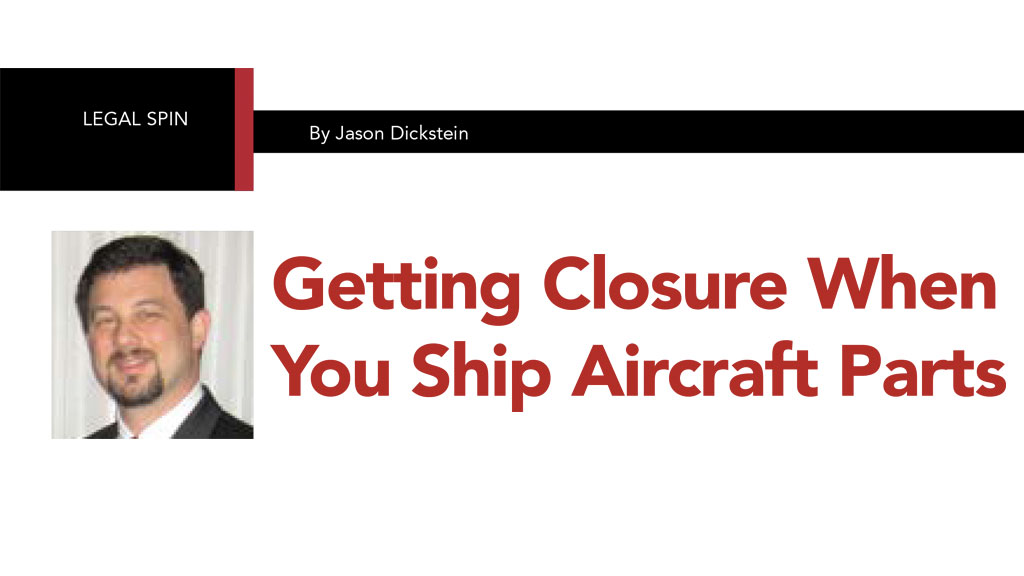Everybody talks about getting closure. It is a theme in pop songs and sappy movies. But surprisingly few discussions exist about closing your packages.
Aircraft parts are shipped throughout the world. When you close the box on a shipment, are you thinking about whether your closure complies with the regulations?
When you ship aircraft parts, there are at least two sets of U. S. government regulations that may impact your package closure. The FAA has regulations concerning export packages, and PHMSA has regulations concerning closure of hazmat packages.
The FAA’s export regulations specify that someone who exports aircraft parts must “[p]reserve and package [the parts] to protect them against corrosion and damage during transit or storage and state the duration of effectiveness of such preservation and packaging.” When this rule was promulgated, the FAA stated “If a product or article does not require any preservation or protective packaging in order to prevent damage, this rule does not apply.” So things that don’t need preservation or protective packaging are not affected by this requirement.
The rule requires the shipper to state the duration of packaging. What does this really mean? It is difficult to tell. When this regulation was first promulgated, I met with FAA executive Frank Paskiewicz to discuss the new rule and the FAA’s expectations. He admitted that the language came from an FAA form and that his team did not have any idea about what metrics they would apply to compliance. He noted that the concept was likely originally related to the concept of expendable, 10 trip and 100 trip packagings from the ATA Specification 300, which recommends packaging standards.
I asked the FAA how they wanted companies to “state the duration of effectiveness of such preservation and packaging.” The FAA did not know at the time, and I was told that the FAA would not be enforcing the regulation until they could issue guidance to explain what it meant. But almost ten years have gone by since that conversation and the executives present have all retired. No guidance has been issued.
The FAA could begin enforcing this rule at any time, despite a lack of any objective standard for how to meet the regulatory requirement. We recommend preserving and packaging aircraft parts for export using standard industry levels of care. We also recommend that the exporter maintain a record that states that the duration of effectiveness of such preservation and packaging is for one trip, unless it is specifically intended for more than one trip.
There are also hazmat regulations that affect closure. Hazmat compliance is important because a surprising number of aircraft parts are regulated as hazardous materials.
For example, the United States regulations require hazmat packages to be properly closed. This means that under normal transportation conditions, hazmat will not be released into the environment and the expected effectiveness of the package will remain consistent with the tested effectiveness. Correlative requirements exist in the IATA Dangerous Goods Regulations (DGR).
How does closure influence the expected effectiveness? In order to ensure that closure does not compromise the expected effectiveness of the package, the regulations require a shipper to follow the manufacturer’s instructions for closing the package. These instructions can often be found printed on a flap on a specification packaging. If they are not printed on the packaging itself, though, then they should be found on a document that accompanies the packaging.
As a shipper, you should always expect closure instructions with your specification packagings, because the manufacturer of a specification packaging is required to provide closure instructions.
The shipper is required to close the package in accordance with the information provided by the manufacturer.
The closure instructions may go into tremendous detail, such as requiring you to use the tape that is provided with the packaging (rather than any other tape) and even explaining precisely where the tape must be applied.
But the manufacturer’s closure instructions must also be read in light of the regulations (compliance with both will typically be required). For example, one regulation that must be obeyed says that a combination packaging containing liquid hazardous materials must be packed so that the closures on the inner packagings are upright (which will make them consistent with the orientation arrows required by the regulations). When using the U.S. regulations you need to follow the packaging regulations found in Part 173 and when using the IATA DGR, you need to follow the Packing Instruction found in the yellow pages of section five.
Most people in our community ship their hazmats by air according to the ICAO Technical Instructions, as those are reprinted in the IATA DGR. The procedure for doing this involves selecting an authorized Packing Instruction which guides the shipper in how to legally package the hazardous materials for shipment. The Packing Instruction will describe what packagings are authorized (e.g. a 4G specification fiberboard box). But the Packing Instruction may have additional packaging instructions that also must be followed. For example, the instructions for packaging Dangerous Goods in Apparatus (which is a commonly used proper shipping name in the aviation industry) are currently found in Packing Instruction 962. Packing Instruction 962 explains that when shipping fuels system components (such as a fuel pump containing fuel residue), each component “must be emptied of fuel as far as practicable and all openings must be sealed securely.” This must be accomplished before the outer packaging is closed (note that this particular Packing Instruction permits the use of non-specification packaging and therefore the outer packaging may not include manufacturer’s closure instructions meeting the requirements of the hazmat regulations as they apply to specification packagings).
Looking for more details? Join us in one of our hazmat classes! We will be teaching a live online hazmat class on April 24-25. The class is live, so you can ask your questions, but it is also online, so you can take the class from the comfort of your own desk. Our class uses the IATA DGR (and some of the U.S. regulations that remain applicable) and goes through the functional steps you need to accomplish in order to remain compliant with U.S. and international law; successful completion of the class yields a training certificate that meets the legal requirements of the U.S. and most other non-U. S. jurisdictions. You can find registration information at www.dangerousgoodstraining.net.

